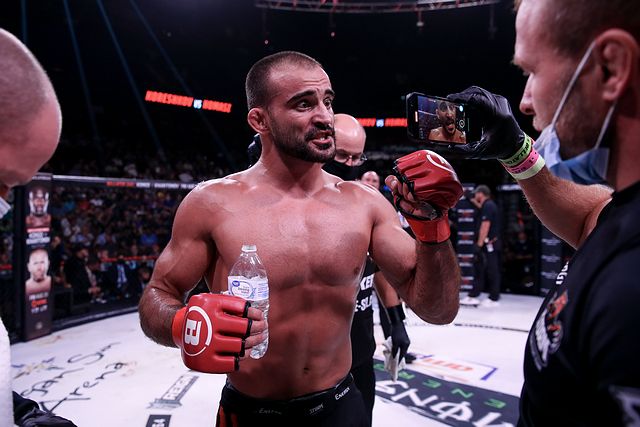Rafael Carino: Where is He Now?
When you ask most veteran mixed martial arts fans about the identity of the first five Brazilians to compete in the Ultimate Fighting Championship, most of them answer Royce Gracie, Marco Ruas, Joe Moreira, Amaury Bitetti and Vitor Belfort. However, there were two Brazilians who stepped inside the Octagon before Belfort: Eldo Dias Xavier (the capoeira stylist who got knocked out by Marcus Bossett in the UFC 4 tournament and today works as an Uber drive in Minas Gerais) and Rafael Carino, who knocked out Matt Andersen in a UFC 9 prelim the same night that Bitetti was beaten by Don Frye.
Unlike Xavier, Carino still contributes to the sport as a jiu-jitsu trainer. Now 49, the sixth-degree black belt and two-time Brazilian jiu-jitsu world champion remembers his one UFC appearance quite vividly.
Advertisement
In addition to the adrenaline associated with a packed Cobo Arena in Detroit, where more than 10,000 people had gathered to witness UFC 9, Carino was forced to deal with the most significant consequence of the political pressures that had been levied by Sen. John McCain. Due to McCain’s efforts, the UFC was obliged to prohibit closed-hand punches the week of the event. With more than 250,000 pay-per-views already purchased, parent company Semaphore Entertainment Group had no choice but to accept the “new rules” suggested by the local commission. Referee John McCarthy entered Carino’s dressing room and advised him that only open-hand punches would be allowed.
“‘Big’ John said that for every closed-hand punch I landed I would
lose $50 and that I could be arrested after the fight if I didn’t
follow his directions,” Carino said. “However, I could see the
previous fights on a TV in the dressing room, and there was a lot
of blood in the Octagon. Everybody was punching, so Pederneiras,
with all of his experience, told me the opposite: ‘For every
closed-hand punch you land, I’ll give you $50. Thank God I decided
to listen to him.”
Carino admits he will never forget the crowd chanting “USA! USA!” before the fight, followed by the absolute silence five minutes later when a sequence of punches from the mount buried Andersen and resulted in the Brazilian newcomer being declared the winner by technical knockout. Bitteti’s TKO loss to Frye in the co-main event led to even more recognition for the young Nova Uniao star.
“Amaury was one of the biggest heroes in the Brazilian jiu-jitsu community. He was one of mine, too,” Carino said. “Guys like Royce, Rickson [Gracie], Ruas and Amaury were on the covers of Tatame and GracieMag [magazines]. For me, it was a future dream, but when Bitetti lost, I ended up being on the cover of Tatame—the most important Brazilian martial arts magazine—at only 23 years old. I traveled there totally unknown and returned a UFC winner. It was just unbelievable.”
Newfound fame ultimately brought misfortune to Carino.
“I totally disappeared from the academy and started using marijuana, which was really terrible for my MMA career,” he said. “Later on, I won many jiu-jitsu competitions in the gi, but Pederneiras always said I could have done much more—mainly in the Pride [Fighting Championships] era.”
Today, Carino uses his own experiences to reach out to others.
“I teach private classes, group classes, but I also have a project where I use jiu-jitsu to help addicted people and also a couple of social projects in the slums,” he said. “I learned from Pederneiras that jiu-jitsu is a great tool to give opportunities to the ones who don’t have them.”
When considering the importance of Pederneiras’ job in relation to assisting the less fortunate, the discussion invariably turns to Jose Aldo. The former World Extreme Cagefighting and UFC champion arrived at Nova Uniao in 2002 with the dream of becoming a professional fighter.
“Pederneiras allowed him to sleep in the dojo, but chose me and two other brown belts to take care of his food,” Carino said. “Each day, one of us was in charge, and if we forgot, Aldo simply wouldn’t eat that day. It was a lot of responsibility.”
Aldo retired from mixed martial arts in September and did so as one of the most accomplished and revered competitors of all-time. He will be inducted into the UFC Hall of Fame this summer.
“I saw how hard this guy worked every single day,” Carino said. “Aldo deserves everything he got. I’m really proud of being part of that history and, most of all, to be a Pederneiras graduate. It’s impossible to say how many poor people he has helped. One of them reached the hall of fame, and others, like Marlon Sandro, Eduardo Dantas and Marcos Galvao, captured world titles. However, there were thousands of others who didn’t reach the highest levels, and he never stopped helping them. Pederneiras is a unique person and a big example to everyone around him.”
« Previous UFC 284 Medical Suspensions: Yair Rodriguez, Josh Emmett Facing 6 Months
Next Heavyweights Jairzinho Rozenstruik, Jailton Almeida to Meet at UFC Card on May 13 »
More




 UFC News & Features
UFC News & Features


